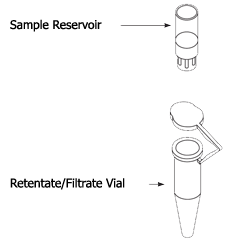Archival Notice
This is an archive page that is no longer being updated. It may contain outdated information and links may no longer function as originally intended.
Home | Glossary | Resources | Help | Contact Us | Course Map
Centrifugal filter units are used to purify and concentrate DNA. When extracting DNA from small or degraded forensic samples, the final concentration of DNA may be too low for subsequent amplification. Although 1ng is a target quantity of DNA for amplification, if 1ng is suspended in 100µl of fluid, it would be impossible to transfer 100µl of this solution into an amplification reaction optimized for 50µl or less. Centrifugal filter units increase the concentration of DNA in solution by retaining the DNA while eliminating a portion of the fluid from the sample. Another benefit of the unit is the ability to secure DNA while contaminants (possibly PCR inhibitors) are washed from the sample.
Centrifugal filter units separate molecules by size through a series of washing and centrifugation steps. The Millipore Corporation produces two centrifugal filter units under the names Centricon® and Microcon®.
Attributes of Centricon® and Microcon® filter units:
- Both employ Amicon® filters to retain the DNA.
- Filter porosity varies.
- Proteins flow through rather than sticking to the surface during centrifugation.
- Filters are anisotrophic, with increasingly smaller interstitial spaces in the direction of filtration allowing for better retention of smaller molecules.
- Filters are composed of regenerated cellulose, which can be sterilized.
- Filters exhibit sufficient strength when wet.
|
Note: |
|
It is important not to spin the unit at rates higher than recommended by the manufacturer because the unit may become compromised, resulting in reduced sample recovery. |
Textile dye molecules, such as indigo, are known PCR inhibitors and are readily washed through the filter. Salts introduced by buffers are removed from the sample during the process. Salts carried over from the process may interfere with capillary electrophoresis.
Read more about capillary electrophoresis in course: Amplified DNA Product Separation.
(You may have to enter your Userid and password.)
|
Note: |
|
Care must be taken to avoid introducing phenol from the organic extraction into the unit because it will break down both the cellulose filter and its supporting silicone rubber o-ring. Chelex® beads carried over from extraction may clog or damage the filter. |
Additional Online Courses
- What Every First Responding Officer Should Know About DNA Evidence
- Collecting DNA Evidence at Property Crime Scenes
- DNA – A Prosecutor’s Practice Notebook
- Crime Scene and DNA Basics
- Laboratory Safety Programs
- DNA Amplification
- Population Genetics and Statistics
- Non-STR DNA Markers: SNPs, Y-STRs, LCN and mtDNA
- Firearms Examiner Training
- Forensic DNA Education for Law Enforcement Decisionmakers
- What Every Investigator and Evidence Technician Should Know About DNA Evidence
- Principles of Forensic DNA for Officers of the Court
- Law 101: Legal Guide for the Forensic Expert
- Laboratory Orientation and Testing of Body Fluids and Tissues
- DNA Extraction and Quantitation
- STR Data Analysis and Interpretation
- Communication Skills, Report Writing, and Courtroom Testimony
- Español for Law Enforcement
- Amplified DNA Product Separation for Forensic Analysts


